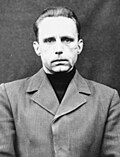Top Qs
Timeline
Chat
Perspective
Doctors' Trial
Post-World War II trial of German doctors for war crimes From Wikipedia, the free encyclopedia
Remove ads
United States of America v. Karl Brandt, et al., commonly known as the Doctors' Trial, was the first of the twelve "Subsequent Nuremberg trials" for war crimes and crimes against humanity after the end of World War II between 1946 and 1947. The accused were 20 physicians and 3 SS officials charged for their involvement in the Aktion T4 programme and Nazi human experimentation.
This article has multiple issues. Please help improve it or discuss these issues on the talk page. (Learn how and when to remove these messages)
|
The Doctors' Trial was held by United States authorities at the Palace of Justice in Nuremberg in the American occupation zone before US military courts, not before the International Military Tribunal.[1] Seven of the accused were sentenced to death by hanging, five were sentenced to life imprisonment, four were given prison sentences from 10 to 20 years, and seven were acquitted.
The judges, heard before Military Tribunal I, were Walter B. Beals (presiding judge) from Washington, Harold L. Sebring from Florida, and Johnson T. Crawford from Oklahoma, with Victor C. Swearingen, a former special assistant to the Attorney General of the United States, as an alternate judge. The Chief of Counsel for the Prosecution was Telford Taylor, and the chief prosecutor was James M. McHaney. The indictment was filed on 25 October 1946; the trial lasted from 9 December that year until 20 August 1947.
Remove ads
Case
Summarize
Perspective

Twenty of the defendants were physicians and three were SS officials (Viktor Brack, Rudolf Brandt, and Wolfram Sievers), all of whom were accused of being involved in Nazi human experimentation and the Aktion T4 programme of involuntary euthanasia. The physicians came from a variety of civilian and military backgrounds, and some were members of the SS. Other Nazi physicians such as Philipp Bouhler, Ernst-Robert Grawitz, Leonardo Conti, and Enno Lolling had died by suicide, while Josef Mengele, one of the leading Nazi doctors, had evaded capture.
In his opening statement, Taylor summarized the crimes of the defendants.[1]
"The defendants in this case are charged with murders, tortures, and other atrocities committed in the name of medical science. The victims of these crimes numbered in the hundreds of thousands. A handful only are still alive; a few of the survivors will appear in this courtroom. But most of these miserable victims were slaughtered outright or died in the course of the tortures to which they were subjected. For the most part, they are nameless, dead. To their murderers, these wretched people were not individuals at all. They came in wholesale lots and were treated worse than animals."
Remove ads
Indictment
Summarize
Perspective
The accused faced four charges, including:[2]
- Conspiracy to commit war crimes and crimes against humanity as described in counts 2 and 3;
- War crimes: performing medical experiments, without the subjects' consent, on prisoners of war and civilians of occupied countries, in the course of which experiments the defendants committed murders, brutalities, cruelties, tortures, atrocities, and other inhuman acts. Also planning and performing the mass murder of prisoners of war and civilians of occupied countries, stigmatized as aged, insane, incurably ill, deformed, and so on, by gas, lethal injections, and diverse other means in nursing homes, hospitals, and asylums during the Euthanasia Program and participating in the mass murder of concentration camp inmates.
- Crimes against humanity: committing crimes described under count 2 also on German nationals.
- Membership in a criminal organization, the SS.
The tribunal largely dropped count 1, stating that the charge was beyond its jurisdiction.
I — Indicted G — Indicted and found guilty
All of the criminals sentenced to death were hanged on 2 June 1948 at Landsberg Prison.
For some, the difference between receiving a prison term and the death sentence was membership in the SS, "an organization declared criminal by the judgement of the International Military Tribunal". However, some SS medical personnel received prison sentences. The degree of personal involvement and/or presiding over groups involved was a factor in others.[citation needed]
Remove ads
See also
References
Further reading
External links
Wikiwand - on
Seamless Wikipedia browsing. On steroids.
Remove ads
























